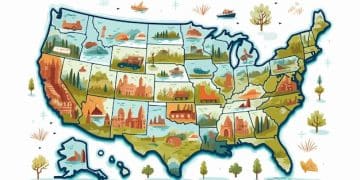The 2025 US Accessible Travel Guide: Resources & Tips

Anúncios
The 2025 Guide to Accessible Travel in the US: Resources and Tips for Travelers with Disabilities provides comprehensive information on planning accessible trips, including transportation, accommodation, activities, and legal rights, ensuring a smoother and more enjoyable travel experience for individuals with disabilities in the United States.
Planning a trip should be exciting, not daunting, especially for travelers with disabilities. With the right resources and preparation, exploring the United States can be an enriching experience. This **The 2025 Guide to Accessible Travel in the US: Resources and Tips for Travelers with Disabilities** provides essential information for ensuring a smooth and enjoyable journey.
Anúncios
Planning Your Accessible Trip: First Steps
Embarking on accessible travel requires careful planning. Start by defining your travel dates, destination, and budget. Consider the specific needs and preferences of the traveler with disabilities to tailor the trip accordingly.
Researching Destinations
Begin by researching destinations that offer a range of accessible attractions and services. Look for cities and national parks known for their accessibility initiatives. Websites and blogs dedicated to accessible travel can provide valuable insights.
Anúncios
Setting a Budget
Determine your budget, considering transportation, accommodation, activities, and any specialized equipment or services needed. Keep in mind that accessible travel may involve additional costs, such as accessible taxis or specialized tours.

To help with budgeting, here are some tips:
- Prioritize essential expenses and look for cost-saving opportunities.
- Consider traveling during the off-season for lower prices.
- Explore discounts and assistance programs for travelers with disabilities.
With careful planning, you can create an itinerary that meets your needs and budget.
Accessible Transportation Options
Navigating transportation is a key aspect of accessible travel. Investigate the accessible transportation options available at your destination, including airports, trains, buses, and taxis.
Air Travel
Airports are increasingly equipped with accessible features, such as wheelchair assistance, accessible restrooms, and visual paging systems. Contact the airline in advance to request any necessary accommodations, such as priority boarding or wheelchair storage.
Train and Bus Travel
Amtrak and Greyhound offer accessible train and bus services, with features such as wheelchair lifts, accessible restrooms, and designated seating areas. Booking in advance is advisable to ensure availability.
Accessible Taxis and Ride-Sharing
Many cities have accessible taxi services or ride-sharing options. Companies like Uber and Lyft may provide wheelchair-accessible vehicles (WAVs). Check local regulations and services availability.
When planning your transportation, consider these factors:
- Book transportation in advance to secure necessary accommodations.
- Confirm accessibility features and services with the transportation provider.
- Allow extra travel time for potential delays or accessibility challenges.
Ensuring reliable and accessible transportation is essential for a stress-free travel experience.
Finding Accessible Accommodation
Accessible accommodation ensures comfort and convenience during your stay. Look for hotels, vacation rentals, and other accommodation options that offer features such as accessible rooms, ramps, and elevators.
Hotel Accessibility Features
When booking a hotel, inquire about accessibility features such as roll-in showers, grab bars, lowered sinks, and visual fire alarms. Many hotels offer accessible rooms that comply with the Americans with Disabilities Act (ADA).
Vacation Rentals
Vacation rentals, such as Airbnb or VRBO, can provide more space and amenities for travelers with disabilities. Filter your search for properties with accessible features and review photos and descriptions carefully.
Checking Reviews and Ratings
Read reviews and ratings from other travelers with disabilities to assess the accessibility of accommodation options. Look for comments about the responsiveness of staff and the availability of accessibility features.

Consider these tips when finding accessible accommodation:
- Book accommodation in advance to secure accessible rooms.
- Confirm accessibility features and services with the accommodation provider.
- Request photos or videos of the accessible room to ensure it meets your needs.
With the right accommodation, you can enjoy a comfortable and relaxing stay.
Accessible Activities and Attractions
Exploring local attractions and activities is an integral part of any trip. Research accessible activities and attractions at your destination, considering your interests and abilities.
Museums and Cultural Institutions
Many museums and cultural institutions offer accessible exhibits, guided tours, and assistive listening devices. Check the attraction’s website or contact them directly to inquire about accessibility features.
National Parks and Outdoor Recreation
National parks are increasingly committed to accessibility, with accessible trails, visitor centers, and campgrounds. Explore accessible outdoor recreation opportunities, such as wheelchair-accessible hiking trails or scenic drives.
Accessible Tours and Excursions
Consider booking accessible tours and excursions tailored to travelers with disabilities. These tours can provide a guided experience of popular attractions, with transportation and accommodations catered to your needs.
Before planning your activities, keep the following in mind:
- Check the accessibility features of the attraction or activity provider.
- Book tours or activities in advance to ensure availability and accommodations.
- Consider your physical limitations and pace yourself to avoid overexertion.
Exploring accessible activities and attractions can create lasting memories of your trip.
Legal Rights and Resources for Travelers with Disabilities
Understanding your legal rights and available resources can empower you to advocate for yourself and ensure equal access to travel services.
The Americans with Disabilities Act (ADA)
The ADA prohibits discrimination based on disability and requires businesses and government entities to provide reasonable accommodations to individuals with disabilities. Learn about your rights under the ADA and how to file a complaint if necessary.
Disability Rights Organizations
Numerous disability rights organizations offer information, advocacy, and support to travelers with disabilities. These organizations can provide guidance on navigating accessibility challenges and accessing resources.
Travel Assistance Programs
Explore travel assistance programs and services that provide financial assistance, equipment loans, or travel companions to individuals with disabilities. These programs can help make travel more affordable and accessible.
When advocating for your rights, remember to:
- Be informed about your legal rights and protections.
- Document any accessibility violations or discriminatory practices.
- Seek assistance from disability rights organizations or legal professionals if needed.
Knowing your rights and available resources can empower you to overcome barriers and enjoy a more equitable travel experience.
Tips for a Smooth and Enjoyable Trip
With careful planning and preparation, you can enhance your travel experience and minimize potential challenges. Consider these tips for a smooth and enjoyable trip:
Pack Smart
Pack essential items, such as medications, mobility aids, and assistive devices. Carry copies of medical prescriptions and insurance information. Consider packing snacks and drinks for travel days.
Communicate Effectively
Communicate your needs and preferences to travel providers, accommodation staff, and tour guides. Be clear and specific about your accessibility requirements. Don’t hesitate to ask for assistance when needed.
Stay Flexible
Be prepared for unexpected changes or challenges during your trip. Maintain a positive attitude and be flexible in your plans. Have backup options in case of unforeseen circumstances.
To help maximize your enjoyment, consider these additional suggestions:
- Allow extra time for travel and activities to reduce stress.
- Pace yourself to avoid overexertion and fatigue.
- Take breaks and recharge as needed.
By adopting these strategies, you can create a travel experience that is both fulfilling and enjoyable.
| Key Point | Brief Description |
|---|---|
| ✈️ Accessible Transportation | Plan transportation in advance, considering accessible airports, trains, and taxis. |
| 🏨 Accessible Accommodation | Book hotels or rentals with ADA-compliant features like roll-in showers and grab bars. |
| 🏞️ Accessible Activities | Explore museums, national parks, and tours that offer accessible options for all. |
| ⚖️ Legal Rights | Understand your rights under the ADA and seek support from disability rights organizations. |
Frequently Asked Questions (FAQs)
▼
Accessible accommodation refers to lodging that provides features like roll-in showers, grab bars, lowered sinks, ramps, and wide doorways, complying with ADA standards to ensure comfort and safety for travelers with disabilities.
▼
Research accessible transportation options such as wheelchair-accessible taxis, ride-sharing services like UberWAV, and public transportation with ramps and designated seating. Booking in advance is highly recommended.
▼
The ADA prohibits discrimination based on disability, mandating reasonable accommodations in businesses and government entities. You have the right to equal access to services and facilities, and can file complaints for violations.
▼
Many national parks offer accessible trails, visitor centers, and campgrounds. Websites and visitor information centers provide resources about accessible features, but be sure to check in advance for specific details.
▼
Pack essential items like medications, mobility aids, assistive devices, and copies of prescriptions. It’s also useful to carry snacks, drinks, and any special equipment needed for daily activities, ensuring comfort throughout your journey.
Conclusion
Accessible travel in the US is becoming more attainable with increasing resources and awareness. By planning ahead, understanding your rights, and utilizing available tools, travelers with disabilities can enjoy enriching and memorable experiences. Embrace the journey and explore the beauty and diversity the United States has to offer.





